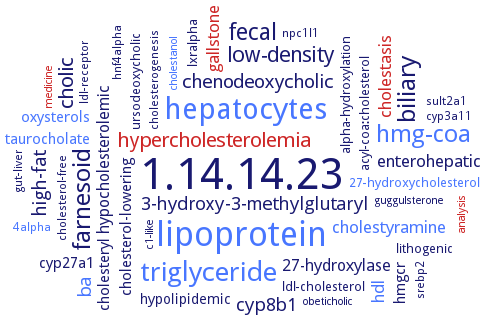Please wait a moment until all data is loaded. This message will disappear when all data is loaded.
Please wait a moment until the data is sorted. This message will disappear when the data is sorted.
activation of an AMP-activated protein kinase decreases CYP7A1 mRNA, hepatocyte nuclear factor 4alpha protein, and binding to CYP7A1 chromatin
-
apobec-1 knock-out mice show a decrease in cholesterol 7alpha-hydroxylase mRNA
atorvastatin induces enzyme Cyp7a1 by suppressing FXR signaling in both liver and intestine. Atorvastatin suppresses the expression of bile acid nuclear receptor farnesoid X receptor (FXR) target genes, namely small heterodimer partner (liver) and fibroblast growth factor 15 (ileum). Atorvastatin increases the mRNAs of the organic cation uptake transporter 1 and cholesterol efflux transporters Abcg5 and Abcg8 in the liver
bile acid-activated farnesoid X receptor, FXR, inhibits CYP7A1 transcription via activation of FGF15 receptor 4 signaling in hepatocytes, or via FGF19, that strongly inhibits CYP7A1 mRNA expression, overview. miR-122a and miR-422a may destabilize CYP7A1 mRNA to inhibit CYP7A1 expression, putative recognition sequences for miR-122a and miR-422a are localized in the 3'-UTR of human CYP7A1 mRNA
-
Chlamydia pneumoniae and human cytomegalovirus infections significantly decrease isoform CYP7A1 promoter activity in a dose-dependent manner, with maximal inhibitions of 33% and 32%, respectively
-
Cyp7a1 is a direct thyroid hormone target gene that responds to physiologic thyroid hormone levels through a set of distinct response elements in its promoter
CYP7A1 mRNAs have very short half-lives, and bile acids destabilize CYP7A1 mRNA via the 3'-untranslated region
-
CYP7A1 protein expression in chronic hypothyroid rats is significantly decreased
-
expression is strongly repressed after 70% partial hepatectomy (during liver regeneration)
-
fibroblast growth factor 19 inhibits cholesterol 7alpha-hydroxylase mRNA expression
-
Forkhead box transcription factor O1 inhibits cholesterol 7alpha-hydroxylase mRNA expression
-
Forkhead box transcription factor O1 inhibits cholesterol 7alpha-hydroxylase mRNA expression in livers of high fat diet-fed mice
-
heat shock factor-1 knockout enhances cholesterol 7alpha hydroxylase (CYP7A1) and multidrug transporter (MDR1) gene expressions to attenuate atherosclerosis
high glucose stimulates bile acid synthesis and induces mRNA expression of cholesterol 7alpha-hydroxylase, the key regulatory gene in bile acid synthesis. Glucose increased ATP levels to inhibit AMPK and induce HNF4alpha to stimulate CYP7A1 gene transcription. Knockdown of ATP-citrate lyase, which converts citrate to acetyl-CoA, decreases histone acetylation, and attenuates glucose induction of CYP7A1 mRNA expression
-
in farnesoid X receptor-deficient and wild-type mice with hypercholesterolemia, injection of 1alpha,25-dihydroxyvitamin D3 consistently reduces levels of plasma and liver cholesterol and farnesoid X receptor small heterodimer partner Shp mRNA, and increases hepatic Cyp7a1 mRNA and protein. The transcription factors, liver receptor homolog-1 (NR5A2) and hepatocyte nuclear factor 4a (NR2A1), are essential for CYP7A1 expression
in farnesoid X receptor-deficient and wild-type mice with hypercholesterolemia, injection of 1alpha,25-dihydroxyvitamin D3 consistently reduces levels of plasma and liver cholesterol and farnesoid X receptor small heterodimer partner, Shp, mRNA, and increases hepatic Cyp7a1 mRNA and protein. The transcription factors, liver receptor homolog-1 (NR5A2) and hepatocyte nuclear factor 4a (NR2A1), are essential for CYP7A1 expression
increase in cholesterol 7alpha-hydroxylase mRNA expression at 16 h (10 h of light) demonstrates a shift in the diurnal rhythm at day 10 postpartum
-
lithocholic acid-acetate and 1alpha,25-dihydroxy-vitamin D3 inhibit cholesterol 7alpha-hydroxylase mRNA expression
-
postpartum: increase in mRNA and protein levels of cholesterol 7alpha-hydroxylase
-
rodent Cyp7a1 expression increases in response to cholesterol-enriched diets, resulting in increased bile acid synthesis
-
several negative feedback loops within the liver and small intestine down-regulate Cyp7a1 transcription to prevent accumulation of bile acids to toxic levels. The the JNK/c-Jun pathway is involved in downregulation of Cyp7a1, overview
-
several nutritive peptides inhibit luciferase expression (cyp7alpha-reporter gene (promoter fragment fused to firefly luciferase))
-
significant increase in Cyp7a1 levels in neonatal hamsters is due to mechanisms independent of the FXR and SHP pathway and cortisol. Precocious expression of Cyp7a1 can not be induced in neonatal hamsters with dexamethasone
-
the amount of methionine and cystine in a diet affects cholesterol 7 alpha-hydroxylase activity
-
upregulation of CYP7A1 mRNA in hypercholesterolemic rats treated with extracts from steamed and dried roots of Panax ginseng C.A. Meyer, and upregulation of CYP7A1 mRNA and protein levels by the addition of ginsenosides Ro, Rg3, Re, Rg1, and Rg2 to rat primary hepatocytes
-
atorvastatin induces enzyme Cyp7a1 by suppressing FXR signaling in both liver and intestine. Atorvastatin suppresses the expression of bile acid nuclear receptor farnesoid X receptor (FXR) target genes, namely small heterodimer partner (liver) and fibroblast growth factor 15 (ileum). Atorvastatin increases the mRNAs of the organic cation uptake transporter 1 and cholesterol efflux transporters Abcg5 and Abcg8 in the liver

atorvastatin induces enzyme Cyp7a1 by suppressing FXR signaling in both liver and intestine. Atorvastatin suppresses the expression of bile acid nuclear receptor farnesoid X receptor (FXR) target genes, namely small heterodimer partner (liver) and fibroblast growth factor 15 (ileum). Atorvastatin increases the mRNAs of the organic cation uptake transporter 1 and cholesterol efflux transporters Abcg5 and Abcg8 in the liver
-
-
in farnesoid X receptor-deficient and wild-type mice with hypercholesterolemia, injection of 1alpha,25-dihydroxyvitamin D3 consistently reduces levels of plasma and liver cholesterol and farnesoid X receptor small heterodimer partner, Shp, mRNA, and increases hepatic Cyp7a1 mRNA and protein. The transcription factors, liver receptor homolog-1 (NR5A2) and hepatocyte nuclear factor 4a (NR2A1), are essential for CYP7A1 expression

in farnesoid X receptor-deficient and wild-type mice with hypercholesterolemia, injection of 1alpha,25-dihydroxyvitamin D3 consistently reduces levels of plasma and liver cholesterol and farnesoid X receptor small heterodimer partner, Shp, mRNA, and increases hepatic Cyp7a1 mRNA and protein. The transcription factors, liver receptor homolog-1 (NR5A2) and hepatocyte nuclear factor 4a (NR2A1), are essential for CYP7A1 expression
-
-




 results (
results ( results (
results ( top
top





